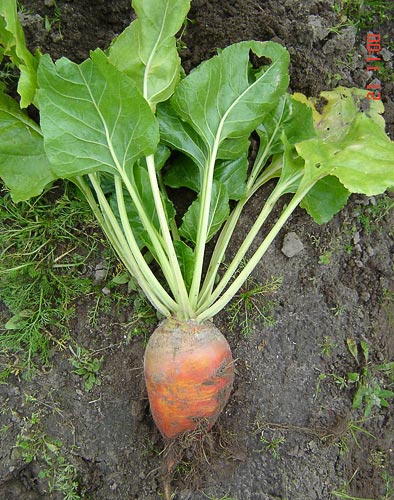Crops
Beta vulgaris L. ssp vulgaris var. alba - Fodder beet.
Taxonomic position.
Family Chenopodiaceae Vent, genue Beta L.Biology and morphology.
The morphological features are similar to sugar beet. Biennial plant. The radical rosette of largy leaves with well advanced leafstalk and thickened pulpy root named a root crop are formed in the first year. Leaves green (different shades) or reddish, juicy, rather large , heart-shaped with twisted top, smooth or corrugated. Root crops depending on sort differ by the form, size and colouring (white, yellow, pink, orange). Weight of root 460-2300 g. Peduncule stalks are formed in the second year. They are ridge, thick, branchy, leaf-bearing, up to 150 cm height. Flowers are androgynous, octamerous, green or albesent, small, cross-pollinated, collected by 2-6 in the floral leaf axil. Peduncular shoots with inflorescences can be regard as verticillate spicate raceme. Fruit is nutlet. Size and weight depend on the grade (approximately 2x1,5x1 mm). Maturing fruits grow together in compound fruit (balls), consisting of 2-6 nutlets. Compound fruits serve as a sowing material.4 groups of grades are distinguished by the form of root crops and depth of their dipping in the ground:
1. Grades with cylindrical or sacculate forms of root crops with strongly advanced neck owing to what 1/4-1/5 of root crops is shipped in the ground (Ekkendorfskaya zheltaya, Arnim Krivenskaya, Gibris timir'azevskij 56).
2. Grades with the lengthened - oval form of root crops, which are shipped in ground for 1/3 lengths and more (Barres, Pobeditel', Severnaya oranzhevaya, Sibirskaya oranzhevaya).
3. Grades with the conic form of root crops, which are shipped in the ground for 1/2 lengths and more (Polusakharnaya belaya, Poltavskaya belaya, Pervenets, Kievskaya).
4. Grades with spherical or orbicular forms root crops, which 1/4 is shipped in ground (Sakharnaya okruglaya 0143, Start).
Distribution.
N.I.Vavilov counted Mediterranean as the initial, and Asia Minor as the secondary center of origin of cultural beet. It appeared in Moscow Russ in 14-17 century. Now it is the leading root crop. On territory of the former USSR the species is distributed everywhere. Exists more than 44 zoned grades. Grades of the first and second groups are cultivated mainly in the Nonchernozem zone and in northern regions of the Central-Chernozem zone.Ecology.
Moderate requiring to heat and soil fertility. Seeds sprout at temperature 2-5° C, shoots are appeared at temperature 12-15° C. Shoots tolerate to short frosts up to minus 3-4° C. Optimum temperature of growth 15-20° C. Prefers loamy, sandy soil, rich with organic substances, with pH not less than 6-7. It is requiring to illumination and humidity, especially during germinating and new growth development. Significant salt resistance, promote to soil desalinization. Vegetative period 120-145 days.Economic value.
Excellent lactiferous forage for large horned livestock and pigs. Root crops contain 75-85 % water, 6-12 % sugars, 3.1 % protein, 0.3-0.7 % fat, 1.6 % cellulose, 8-12 % watersoluble dry substances, vitamines; have a good keeping quality. Productivity of root crops 40-60 (by watering till 250) ton per hectare and more, productivity of botva - 20-30 ton per hectare.The literature.
Bases of agriculture and plant growing. Ed by V.S.Nikljaev. Moscow.1990, p. 401Bondarchuk N.M., Vasil'ev V.I., Fomichev A.M. Beet fodder. Barnaul, 1988
Burenin V.I., Pivovarov V.F. Beet. St. Petersburg, 1998
Korenev G.V. Rastenievodstvo s osnovami selekcii i semenovodstva. M. 1990
Massino I.V., Akhmedova S.M., Eremenko O.V. Beet fodder in Uzbekistan. Tashkent, 1986
Mikheev V.V. To farmers about Beet fodder production. Moscow, 1996
Shevtsov I.A., Fomichev A.M. Biology and agrotechnic of Beet fodder. Kiev, 1980
Teregulov H.G. Beet fodder. Ufa, 1974
Vehov V.N., Gubanov I.A., Lebedeva G.F. Cultural plants of the USSR. Moscow. 1978
Zosimovich V.P. Evolution of wild and cultural beet. The author's abstract of PhD. Kiev, 1958


